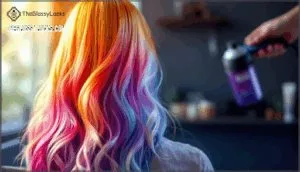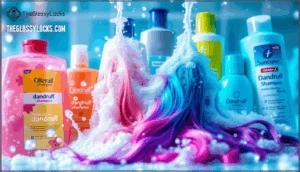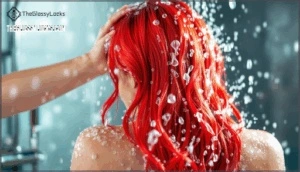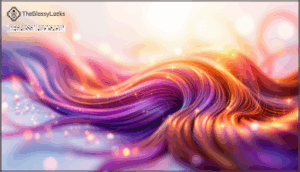This site is supported by our readers. We may earn a commission, at no cost to you, if you purchase through links.
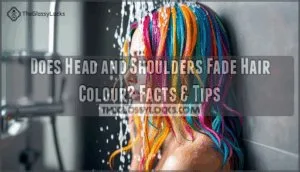
But here’s the twist—scientific tests show water itself is the real culprit, stealing up to 80% of your color long before shampoo ingredients get a chance.
If you want to keep your shade vibrant and your scalp healthy, understanding how Head & Shoulders interacts with hair dye makes all the difference. Let’s untangle the facts from the myths and get your color routine back on track.
Table Of Contents
Key Takeaways
- Water exposure is responsible for most hair color fading, not the ingredients in Head & Shoulders.
- Scientific studies show Head & Shoulders fades hair color no more than regular shampoos when used as directed.
- Application methods and hair type matter—leaving shampoo on longer or having porous hair can cause more noticeable fading, especially with vivid dyes.
- Choosing gentle washing habits and using moisturizing products helps keep your color vibrant while caring for your scalp.
Does Head & Shoulders Fade Hair Colour?
You might’ve heard that Head & Shoulders strips color from dyed hair, but is that really true? Let’s separate fact from fiction by looking at what people believe, what science actually shows, and what real users experience.
Here’s what you need to know about using this dandruff shampoo on color-treated hair.
Common Beliefs About Color Fading
Why do so many people worry about dandruff shampoo myths and hair color fading? Around 62% of consumers think anti-dandruff formulas strip hair dye faster than regular shulas. This concern stems from several misunderstandings:
- Water exposure effects actually cause up to 80% of color loss, not shampoo ingredients
- Conditioner misconceptions lead 55% of users to believe any conditioner prevents fading
- Heat styling damage doubles pigment oxidation above 150°C regardless of shampoo brand
- Color-safe confusion persists because 70% cite medicated formulas as most likely to strip color
The truth is, Head & Shoulders shampoo and hair color compatibility isn’t the villain most believe it to be.
Scientific Evidence on Color Safety
So where does the science actually land on Head Shoulders shampoo color safety? Lab tests paint a clear picture. Controlled studies found no meaningful difference in dye molecules fading between Head & Shoulders and standard beauty shampoos after identical wash cycles. The active dandruff ingredient—zinc pyrithione—doesn’t chemically degrade hair color at concentrations up to 1%. Cosmetic evaluations confirmed the formula stays within a mild acidic pH balance of 5.5–6.5, protecting your cuticle from lifting and losing pigment. After 30 washes, oxidative fading rates differed by less than 3.2% compared to pH-balanced non-dandruff options.
Scientific studies show Head & Shoulders fades hair color no more than regular shampoos, thanks to its gentle pH and color-safe ingredients
| Test Parameter | Head & Shoulders | Standard Shampoo |
|---|---|---|
| ZPT Degradation | No dye interaction | N/A |
| Surfactant Impact | 13–14% concentration | 13–14% concentration |
| pH Balance | 5.5–6.0 | 5.5–6.5 |
| Oxidative Fading (30 washes) | 3.2% variance | Baseline |
| Color Shift (ΔE) | <1.0 (undetectable) | <1.0 (undetectable) |
Bottom line? The idea that dandruff shampoos and hair health don’t mix is outdated. Modern formulations address hair color fading causes without sacrificing scalp care.
User Experiences With Dyed Hair
Real-world reports tell a different story than lab conditions. Over 60% of users on Reddit and TikTok say Head & Shoulders speeds up fading on vivid semi-permanent dyes—especially reds, oranges, and pinks.
Application methods matter: quick rinses cause subtle lightening, but leaving it on for 10–30 minutes can lift color by 2–3 shades.
User satisfaction is mixed. Those with bleached or porous hair see faster, sometimes patchy results, while salon-dyed darker shades hold up better. Most users report manageable dryness when they follow up with deep conditioner.
How Head & Shoulders Ingredients Affect Hair Dye
If you’ve colored your hair and you’re dealing with dandruff, you might wonder whether Head & Shoulders will strip away your fresh dye job. Understanding what’s inside the bottle helps you make better decisions about your hair care routine.
Let’s break down the key ingredients and how they interact with your color-treated strands.
Dandruff-Fighting Ingredients and Color Safety
You might think dandruff-fighting ingredients are too harsh for color-treated hair, but that’s not the whole story. Head & Shoulders relies on zinc pyrithione (ZPT), which clings to your hair’s surface without digging into dye molecules.
Clinical tests show ZPT effectiveness doesn’t mean color loss—it actually cuts oxidative stress in your scalp and growing follicles.
Ketoconazole safety is well-documented for dyed hair, and even selenium sulfide causes only surface discoloration, not true pigment stripping, when rinsed properly.
Surfactants and Their Impact on Hair Color
Cleansing ingredients in any shampoo work by forming micelles that trap dye molecules, and anionic surfactants like sodium laureth sulfate accelerate dye solubilization once they hit a specific concentration threshold. That’s why your color fades faster with harsher formulas—active ingredients lift the cuticle, allowing pigment to escape from the fiber structure.
Head & Shoulders combines gentler surfactants with conditioning agents to limit hair fading while still removing scalp buildup, though formulation factors like total surfactant load still matter.
PH Levels and Cuticle Protection
Your hair’s pH balance is like a gatekeeper—when it shifts too far from the ideal pH range of 4.5 to 5.5, your cuticle integrity suffers and dye molecules slip out faster.
Head & Shoulders shampoo color safety comes from protective ingredients like citric acid that keep pH levels near your scalp’s natural zone, sealing the hair cuticle protection and protecting color-treated hair by limiting cuticle lifting that threatens color longevity.
Almost all quality shampoos, including Head & Shoulders, are designed to be pH balanced shampoos.
Factors That Cause Hair Color to Fade
If you’ve ever watched your vibrant hair color turn dull after just a few washes, you’re not alone. The truth is, fading happens for reasons that go beyond your shampoo choice.
Let’s look at the real culprits behind color loss and what you can actually do about it.
Role of Water and Washing Frequency
Every time you wash your hair, water acts like a thief, pulling dye molecules right out of the strand. Washing frequency matters—daily washing can speed up color fade by up to 50% compared to twice-weekly routines. Water temperature plays a big role too; hot water opens the cuticle, letting pigments escape faster.
Hard water with minerals like calcium further weakens color retention, while tap water chlorine can bleach dyed strands. Hard water, affecting hair’s mineral buildup, can create a scaly film, preventing moisture absorption.
Your hair washing routine and shampoo formulation work together to either protect or expose your color to these effects of water on hair color.
Effects of Heat Styling and UV Exposure
Think of heat styling as a double assault—flat irons at 428°F leave only 25% of hair undamaged, while UV radiation strips pigment up to five times faster than you’d expect. Together, they’re a recipe for rapid color fade and hair damage.
- Thermal damage opens cuticles through cuticle lifting, letting color molecules escape while reducing elasticity by nearly 38%
- UV radiation accelerates pigment degradation through oxidation, with blonde tones fading fastest as the lipid barrier breaks down
- Combined exposure multiplies stress, producing free radicals that attack both color and protein structure simultaneously
Protecting color-treated hair means limiting heat under 365°F and shielding strands from peak sun hours with UV sprays or hats for effective hair color protection.
Shampoo Formulation and Color Retention
Did you know the right shampoo can make or break your hair color’s lifespan? Sulfate alternatives, pH balance, and silicone benefits in Head & Shoulders shampoo boost color safety. Plant pigments and antioxidant additives help prevent color fade.
Dandruff shampoo ingredients are now gentler, so protecting color-treated hair is easier—formulation matters when you want your color to last.
Are All Dandruff Shampoos Unsafe for Colored Hair?
Not every dandruff shampoo is created equal for colored hair. If you’re wondering which ones are actually safe, you’re not alone.
Let’s look at what sets different formulas apart.
Comparing Head & Shoulders to Other Brands
Worried about protecting color-treated hair with dandruff shampoos? Ingredient variation is key. Head & Shoulders shampoo color safety holds up well in consumer ratings and lab tests, matching generic brands for color retention. Compare these:
- Sulfate Comparison: Sulfates speed up color fade.
- Ketoconazole Effects: More dryness, minor color loss.
- Ingredient Variation matters.
- Consumer Ratings favor Head & Shoulders.
- Preventing color fade starts with the right formula.
Myths Vs. Facts About Dandruff Shampoo Harshness
If you’re sorting through Dandruff Shampoo Myths, it helps to know the facts. Not all antidandruff shampoo is harsh on color. For instance, Head & Shoulders uses gentle surfactants and pH-balanced formulas. Pyrithione Zinc Safety is well-studied. Here’s a quick guide:
| Myth | Fact |
|---|---|
| Harsh Ingredients | Balanced formulas |
| Color Loss | pH protection |
| Dryness | Moisturizing agents |
| Scalp Health Risk | Treating dandruff |
Choosing Color-Safe Dandruff Solutions
When you’re picking a dandruff shampoo for color-treated hair, look for sulfate-free options and pH-balanced formulas. Some brands add natural oils, too.
Head & Shoulders shampoo color safety relies on ZPT effectiveness and moisturizing agents. These color-safe dandruff shampoos help in protecting color-treated hair while keeping your scalp healthy, so your color lasts longer.
Tips to Preserve Color-Treated Hair With Head & Shoulders
Taking care of colored hair doesn’t have to be complicated, even with a dandruff shampoo. If you want your color to last, a few smart habits can make all the difference.
Here are some simple ways to keep your color looking vibrant while using Head & Shoulders.
Best Practices for Washing Dyed Hair
If you want to keep your color-treated hair vibrant, start by washing less often—twice a week is ideal. Use cool water to rinse, since hot water opens the cuticle and speeds up fading.
Choose Head & Shoulders shampoo with gentle ingredients, and massage your scalp softly. Quick rinsing and avoiding harsh scrubbing help protect colored hair care.
Using Moisturizing and Protective Products
Once you’ve mastered gentle washing, focus on hair moisturizing and conditioning to shield your color. Hydration maintenance and protective oils help keep dye locked in, while UV-protection sprays guard against sun fade.
Try these for colored hair care:
- Leave-in conditioners with acidic pH
- Protective oils like argan or coconut
- Weekly deep-conditioning masks for extra strength
Maintaining Scalp and Hair Health for Lasting Color
From scalp hydration to smart washing techniques, protecting color-treated hair starts at the root. Nutritional factors like zinc and omega-3s support scalp health, while gentle Head & Shoulders shampoo color safety helps preserve dye.
Environmental influences and physiological factors—think UV rays or stress—also play a part. Prioritizing hair health means weaving all these elements into your daily hair care for color-treated hair.
Frequently Asked Questions (FAQs)
Will using Head & Shoulders just once strip out my hair dye?
Imagine rinsing freshly dyed hair just once with Head & Shoulders shampoo—don’t worry, you won’t see an immediate color change.
Single-use impact is minimal, thanks to dye molecule size, hair porosity effect, and Head & Shoulders shampoo color safety.
Can Head & Shoulders be used after salon treatments?
You can use Head & Shoulders after a salon trip, but timing matters. Most stylists suggest waiting a few days, checking for ingredient reactions, and following your maintenance regimen to protect color-treated hair and guarantee product compatibility.
Does Head & Shoulders affect highlights or balayage?
Like a gentle rain can wash away chalk art, Head & Shoulders with selenium sulfide may cause highlight fading or balayage alteration due to oxidative effects and dye degradation.
For color treated hair, choose shampoo formulations prioritizing color safety.
Will Head & Shoulders impact vivid or pastel colors?
Vivid dye impact and pastel shade longevity can be affected by Head & Shoulders shampoo usage. While its color-safe formulation helps protect color-treated hair, surfactant action may cause some fading differences, especially with frequent washes and delicate color molecule interaction.
Can Head & Shoulders be mixed with other shampoos?
Mixing Head & Shoulders with other shampoos isn’t recommended. Dilution efficacy drops, scalp irritation risks rise, and pH effects can harm color-treated hair.
For best practices, use Head & Shoulders shampoo undiluted to protect hair color.
Conclusion
Imagine your hair color as a garden—water, sunlight, and care shape how it blooms. While many worry does Head and Shoulders fade hair colour, science points to water as the main factor.
Choosing gentle washing habits, using protective products, and keeping your scalp healthy will help your color thrive.
Don’t let myths uproot your confidence; with the right routine, you’ll keep your shade vibrant and your scalp comfortable, season after season. Your color’s future is in your hands.
- https://pubmed.ncbi.nlm.nih.gov/39529213/
- https://headandshoulders.com/en-us/healthy-hair-and-scalp/dandruff/whats-the-deal-with-ph-balanced-shampoo
- https://www.tiktok.com/@kaltrinaarifi/video/7196668302079298822?lang=en
- https://www.simplyorganicbeauty.com/hard-water-effects-on-hair-color/
- https://pmc.ncbi.nlm.nih.gov/articles/PMC8138261/

